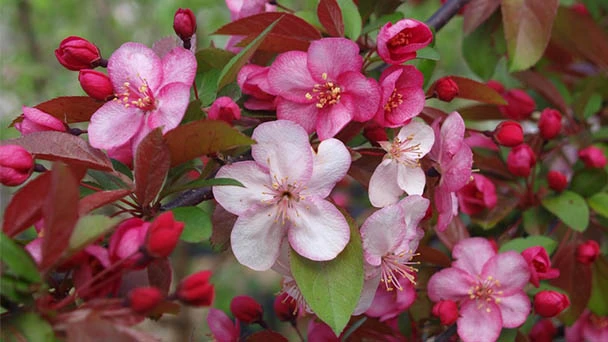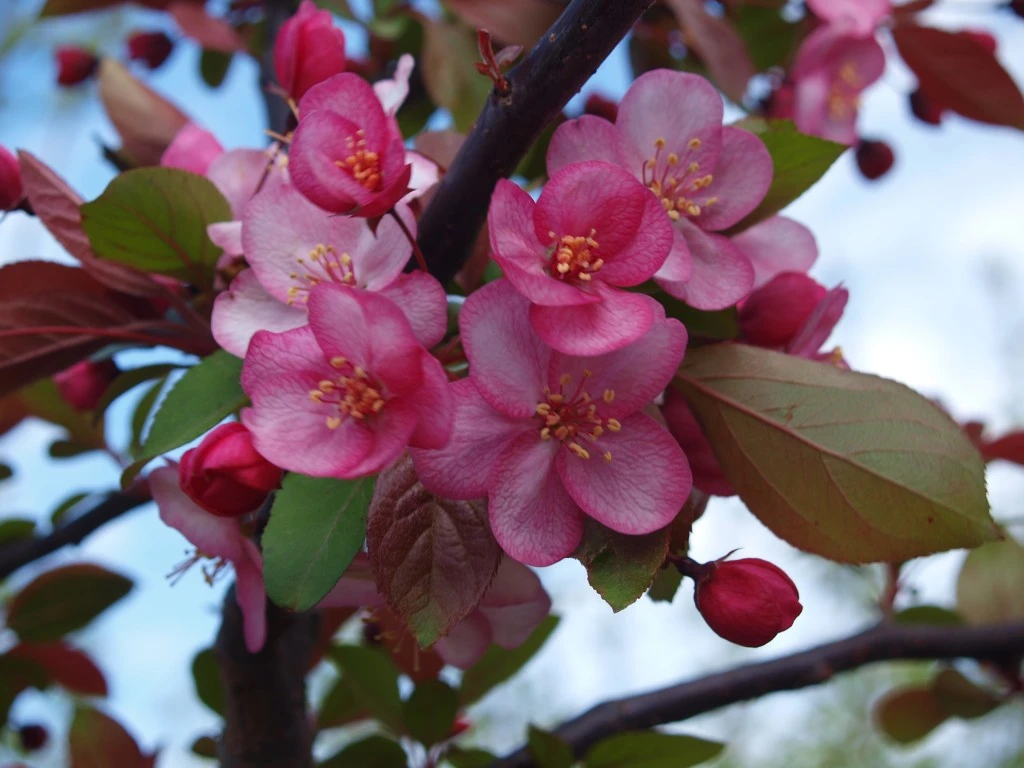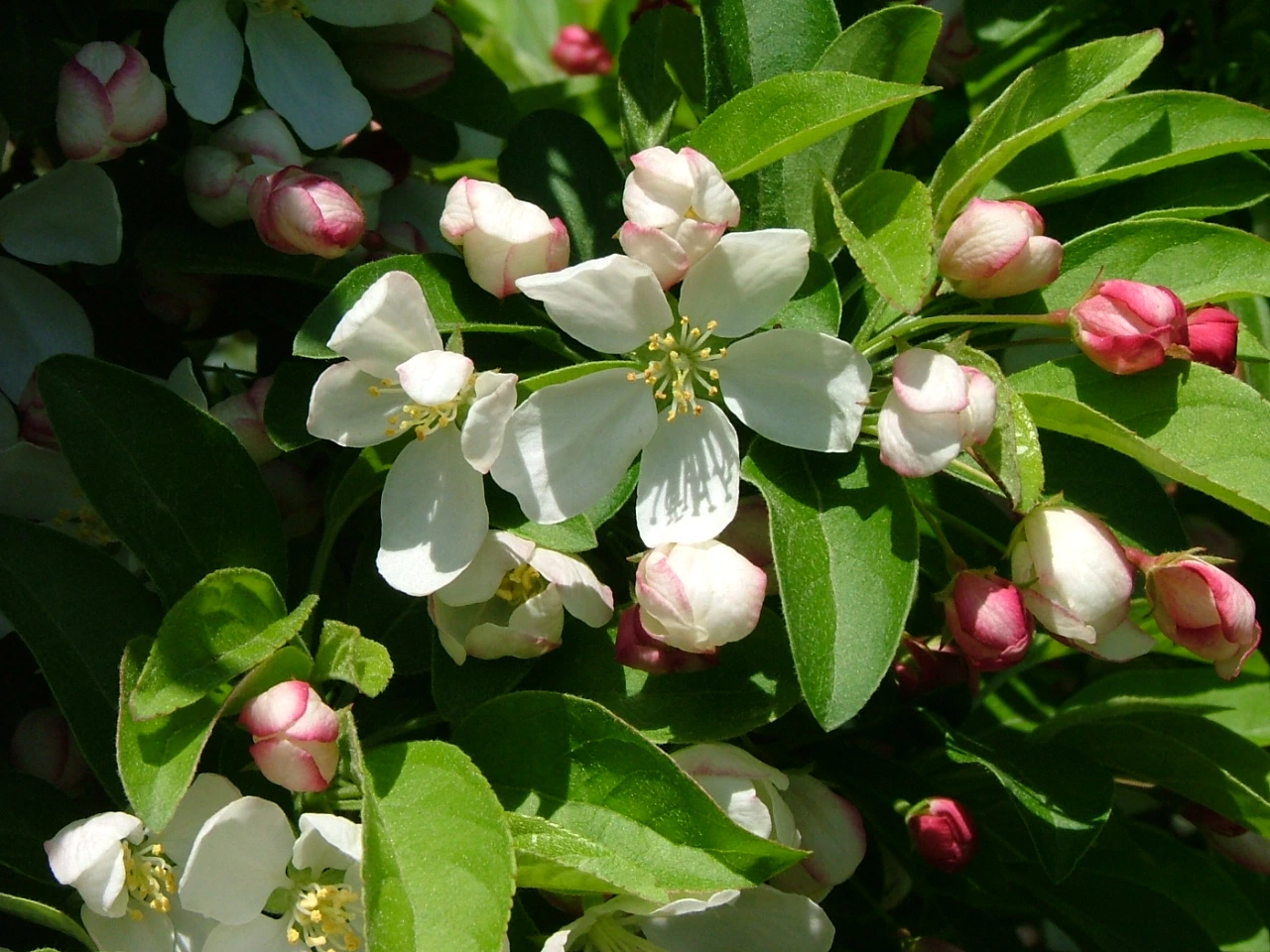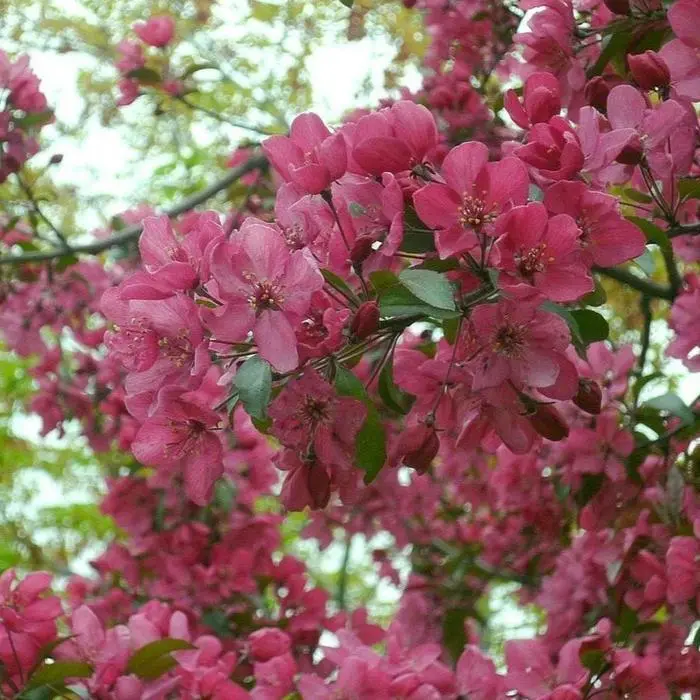How to Grow and Care for Crabapple Tree (Malus)
Written by Ivy
Nov 15 2021

Crabapple tree (Malus) is a woody plant. Moreover, the tree shape of crabapple tree is relatively large, and the yield is relatively large in the later stage. Crabapple tree planting technology is not very mature. Today, I will briefly explain the planting conditions and propagation methods of crabapple tree.
The fruit of crabapple tree should not be picked too early or too late. If it is too early, the taste of crabapple will be greatly reduced. If it is too late, it is not conducive to storage. Under normal circumstances, we should appropriately accelerate the ripening of the storage process when we start picking crabapple tree fruits.
Crabapple tree enters the flowering period with vigorous growth and lush branches and leaves. A certain amount of fertilizer needs to be applied regularly whether it is vegetative growth or flowering period. Before planting, apply basic fertilizer, 30kg diamine phosphate per mu and 1500kg rotten manure per mu. We applied nitrogen, phosphorus and potassium compound fertilizer to each seedling at the new bud growth stage, flowering stage and pre defoliation stage of crabapple tree.
After the crabapple tree pruning, the branches with unreasonable growth were pruned, but many crabapple trees that can breed flower buds sprouted some axillary buds, which can not be pruned directly, but it is difficult to bloom if they are retained directly. Therefore, prune at the position above the axillary bud. The incision must be at a certain distance above the axillary bud, preferably 5mm. In this way, slightly inclined pruning can give the flower bud sufficient growth space and nutrients, which is conducive to flowering and lateral branch growth in the coming year.
We can treat this crabapple tree disease with corresponding therapeutic drugs. If the disease cannot be alleviated, the specific drugs nitrile azole EC, flusilazole water dispersant and Triadimefon EC should be used alternately.
1. Prepare Cuttings: select branches with normal growth and 1-2 flower buds and cut them. Then use scissors to cut it short into small segments 5-6cm long, and then cut the bottom of it obliquely.
2. Preparation of Substrate: the substrate can leave more growth space for the young roots of crabapple tree. It is necessary to use flower soil with more gaps and high particle content as the substrate. It is recommended to mix rotten leaf soil and river sand to make the matrix for cutting.
3. Cutting: we can soak crabapple tree cuttings in sterilized water for 20 minutes and then take them out to dry. Then slowly insert it into the flower soil to make the part about 2-3cm long enter the soil.
4. Post Caring: after completing crabapple tree propagation from cutting, we can put it in a relatively cool place at about 20 ℃ for slow curing. Replenish water regularly during the period to keep the matrix slightly wet, and it will grow roots soon.
Then we can cut off the top of the rootstock and use a single-sided blade to cut down along the pith core. The depth of the knife edge is 1.6 ~ 2.2 cm. Quickly cut the front and back sides of the scion into a positive wedge (V) cut of about 1.52.0 cm; We can use a blade to pull out the anvil incision and immediately insert it into the large anvil incision until the bottom of the incision. Pay attention to prevent the cortex from cracking and align the two cambium.
Then we can use plastic film strips to bind from bottom to top, and finally put on plastic bags to tie other branches of rootstock at the mouth of bags. The grafting method is the same. After crabapple tree propagation from grading, we should put the flowerpot in a shade with sufficient light and good ventilation to ensure that the scion will not be exposed to sun and rain in a short time and control the temperature. Generally, the interface can heal and produce new conducting tissue in 20 ~ 30 days.
Crabapple is relatively rich in vitamins, including vitamin A, vitamin C, vitamin E, riboflavin, thiamine and niacin. Human daily activities are inseparable from these nutrients. For example, the protection of human vision is inseparable from the participation of vitamin A. skin beauty needs the participation of vitamin C and vitamin E.
Crabapple is also rich in trace elements, such as calcium, phosphorus, potassium, sodium, iron, etc. these elements are of great significance to maintain human health. If the human body is short of iron, it will lead to iron deficiency anemia, and calcium is the only guarantee to ensure the strength of human bones and prevent osteoporosis.
Crabapple tastes slightly sour because it is rich in organic acids, which can help the digestion of human intestines and stomach.
Crabapple Tree Quick InfoWhen to Plant Crabapple TreeWhen does Crabapple Tree Bloom & HarvestCrabapple Tree Care in DetailCrabapple Tree WateringCrabapple Tree SoilCrabapple Tree LightCrabapple Tree TemperatureCrabapple Tree HumidityCrabapple Tree FertilizerCrabapple Tree PruningCrabapple Tree RepottingCrabapple Tree Pest & Disease ControlCrabapple Tree PropagationCrabapple Tree Propagation from CuttingCrabapple Tree Propagation from GraftingCrabapple Tree Propagation from SeedCrabapple Tree Benefits
Crabapple Tree Quick Info
| Botanical/Scientific Name | Malus |
| Common Name | Crabapple Tree |
| When to Grow/Bloom/Harvest | Plant in the spring or fall/Crabapple blossoms appear in April to May/Harvest in the late summer and fall |
| Uses | Good jams and jellies |
| Origin | North America, Europe, Asia |
| Light Care | Full sun |
| Soil Care | Well-drained soil |
| Temperature Care | 32 and 45 degrees F |
| Humidity Care | Moist |
| Watering | Regular watering |
| Pruning Care | Pruning when the tree is dormant |
| Fertilizer Care | All-purpose fertilizer |
| Propagation | Stem cuttings |
| Toxic | Not toxic to humans |
| Flower Color | Dark pink flowers |
When to Plant Crabapple Tree
Crabapple trees can generally be grafted and planted before budding in spring or from July to September in autumn. Crabapple tree can also reproduce by ramets before budding in spring or after defoliation in autumn and winter. Before sowing in spring, crabapple tree seeds must be treated with low-temperature stratification and germination promotion for 30 ~ 100 days. After crabapple tree is planted, we should always keep the soil loose and fertile. Pond mud or fertile soil can be cultivated in the rhizosphere every autumn.When does Crabapple Tree Bloom & Harvest
Crabapple trees bloom mostly in spring, which is the growth law of crabapple trees, and crabapple trees will harvest in July and August.The fruit of crabapple tree should not be picked too early or too late. If it is too early, the taste of crabapple will be greatly reduced. If it is too late, it is not conducive to storage. Under normal circumstances, we should appropriately accelerate the ripening of the storage process when we start picking crabapple tree fruits.

Crabapple Tree Care in Detail
Crabapple Tree Watering
Crabapple tree belongs to a variety with large scale and high yield, and has a large demand for water and fertilizer. At ordinary times, we must reasonably arrange the drainage and irrigation of the orchard. Although crabapple tree is relatively drought resistant, it should also be watered in time in case of drought and water shortage. The amount of watering should not be too much. In the rainy season, we should remember to drain water in time.Crabapple Tree Soil
The planting soil environment of crabapple tree is the foundation. First of all, we should know that crabapple tree does not like the environment of ponding and is drought resistant. Therefore, in the land for planting Begonia fruit, the soil with sufficient light, high soil fertility and convenient drainage and irrigation should be selected. Before planting crabapple tree, we should prepare the land. The first thing to do is to disinfect the soil to prevent residual pesticides and pests from affecting the growth of Begonia fruit.Crabapple Tree Light
Crabapple tree is a positive tree species, which likes warm sunshine, and the annual sunshine hours must be about 1500 ~ 2000 hours; Through pruning and modeling, we can make the proportion of leaves and fruits appropriate, the spatial distribution of branches reasonable, and increase the ventilation and illumination of plants. During the whole growth period, we should keep the potted crabapple tree in a sunny place to meet its requirements for light.Crabapple Tree Temperature
Crabapple tree is generally suitable for growth under the temperature of 18-22 ℃, but the minimum temperature cannot be lower than 15 ℃; At the same time, if the temperature continues to exceed 28 ℃ in summer, we should take shading and cooling measures for crabapple tree in time. In winter, we can raise the ground temperature to protect crabapple tree.Crabapple Tree Humidity
Crabapple tree should pay attention to shade and heatstroke prevention in summer to ensure that it depends on air humidity. We must not water crabapple tree too much and do not let the soil accumulate water.Crabapple Tree Fertilizer
Generally, during the propagation of crabapple tree, we need Topdressing and base fertilizer with more than two times of fertilization a month. After flowering, potassium fertilizer should be added appropriately, mainly to prevent the branch senescence of crabapple tree fruit. Crabapple can be collected continuously and fertilized every time, which is to provide nutrition for new fruits in the future.Crabapple tree enters the flowering period with vigorous growth and lush branches and leaves. A certain amount of fertilizer needs to be applied regularly whether it is vegetative growth or flowering period. Before planting, apply basic fertilizer, 30kg diamine phosphate per mu and 1500kg rotten manure per mu. We applied nitrogen, phosphorus and potassium compound fertilizer to each seedling at the new bud growth stage, flowering stage and pre defoliation stage of crabapple tree.
Crabapple Tree Pruning
When crabapple tree pruning, we need to identify different branches and prune them according to different branch forms. First of all, we should prune the common crabapple tree's long branches, and then prune the Cross branches, wheel branches, inward branches, upright branches, reverse branches, through branches, abdominal branches, dry branches and sprouting tillers in turn, so as to ensure a transparent internal space and facilitate the ventilation and growth inside the plant.After the crabapple tree pruning, the branches with unreasonable growth were pruned, but many crabapple trees that can breed flower buds sprouted some axillary buds, which can not be pruned directly, but it is difficult to bloom if they are retained directly. Therefore, prune at the position above the axillary bud. The incision must be at a certain distance above the axillary bud, preferably 5mm. In this way, slightly inclined pruning can give the flower bud sufficient growth space and nutrients, which is conducive to flowering and lateral branch growth in the coming year.

Crabapple Tree Repotting
When we are doing crabapple tree repotting, we first separate the basin soil of the old basin. After taking out the plants, we'd better leave a soil ball. The depth of the flower pot for changing the pot of crabapple tree should not be too deep, and then put the plant with soil ball into the new flower pot and add the prepared soil. The soil should be mixed with garden soil, river sand and rotten leaf soil, which is more suitable for the growth of crabapple tree. After changing the basin, pour water once and keep it in the semi shade for a week.Crabapple Tree Pest & Disease Control
Crabapple tree induced disease usually occurs in the late April of each year. Orange dots appear in the early stage, gradually expand, the diseased tissue thickens and the back of the leaf surface bulges. From May to June, yellow and white hairy sporophytes will grow at the bulge on the back of the leaf surface, which will be transferred back in April next year. After the sporophyte is transferred out, the diseased part will turn brown, resulting in leaf death.We can treat this crabapple tree disease with corresponding therapeutic drugs. If the disease cannot be alleviated, the specific drugs nitrile azole EC, flusilazole water dispersant and Triadimefon EC should be used alternately.
Crabapple Tree Propagation
Crabapple Tree Propagation from Cutting
If we want to conduct crabapple tree propagation from cutting, we'd better choose April to may or August to September. Because the temperature in these two periods is about 20 ℃, it is very suitable for its cutting growth. We try not to carry out cutting when it is too hot in summer, because the temperature is too high at this time, it is easy to enter dormancy, so as to reduce the success rate of crabapple tree propagation from cutting.1. Prepare Cuttings: select branches with normal growth and 1-2 flower buds and cut them. Then use scissors to cut it short into small segments 5-6cm long, and then cut the bottom of it obliquely.
2. Preparation of Substrate: the substrate can leave more growth space for the young roots of crabapple tree. It is necessary to use flower soil with more gaps and high particle content as the substrate. It is recommended to mix rotten leaf soil and river sand to make the matrix for cutting.
3. Cutting: we can soak crabapple tree cuttings in sterilized water for 20 minutes and then take them out to dry. Then slowly insert it into the flower soil to make the part about 2-3cm long enter the soil.
4. Post Caring: after completing crabapple tree propagation from cutting, we can put it in a relatively cool place at about 20 ℃ for slow curing. Replenish water regularly during the period to keep the matrix slightly wet, and it will grow roots soon.
Crabapple Tree Propagation from Grafting
For crabapple tree propagation from grafting, we can choose two varieties of early and late ripening Begonia fruit, and graft and reproduce with branches differentiated from flower buds in the first year by cutting. Crabapple tree propagation from grading should be carried out after falling leaves in autumn. When grafting plants, we can first use a disinfection blade to cut the terminal buds growing in the current year on the selected mother plant, and each segment is about 4 ~ 5cm long (Note: the stem thickness of rootstock and scion is basically the same).Then we can cut off the top of the rootstock and use a single-sided blade to cut down along the pith core. The depth of the knife edge is 1.6 ~ 2.2 cm. Quickly cut the front and back sides of the scion into a positive wedge (V) cut of about 1.52.0 cm; We can use a blade to pull out the anvil incision and immediately insert it into the large anvil incision until the bottom of the incision. Pay attention to prevent the cortex from cracking and align the two cambium.
Then we can use plastic film strips to bind from bottom to top, and finally put on plastic bags to tie other branches of rootstock at the mouth of bags. The grafting method is the same. After crabapple tree propagation from grading, we should put the flowerpot in a shade with sufficient light and good ventilation to ensure that the scion will not be exposed to sun and rain in a short time and control the temperature. Generally, the interface can heal and produce new conducting tissue in 20 ~ 30 days.
Crabapple Tree Propagation from Seed
After crabapple's seeds mature, there is still a period of dormancy. Crabapple seeds can be stored in wet sand for 80 ~ 100 days, and crabapple seeds can be sown in the early spring of the next year. The seedbed can be sunny, slightly higher and fertile. After applying enough base fertilizer, it can be deeply turned into a fine furrow, which can also be filled with mountain soil and rotten leaf soil; During crabapple tree propagation from seed, we can screen out the seeds, sow them on demand, cover the seedbed with fine sand, spray water through with a fine hole watering can, and cover the seedbed with a thin layer of straw to keep the matrix moist.
Crabapple Tree Benefits
The carbohydrates contained in every 100g crabapple are about 19.2g. We all know that carbohydrates can directly provide energy for the human body after digestion and absorption, so they are an indispensable nutrient element for the human body.Crabapple is relatively rich in vitamins, including vitamin A, vitamin C, vitamin E, riboflavin, thiamine and niacin. Human daily activities are inseparable from these nutrients. For example, the protection of human vision is inseparable from the participation of vitamin A. skin beauty needs the participation of vitamin C and vitamin E.
Crabapple is also rich in trace elements, such as calcium, phosphorus, potassium, sodium, iron, etc. these elements are of great significance to maintain human health. If the human body is short of iron, it will lead to iron deficiency anemia, and calcium is the only guarantee to ensure the strength of human bones and prevent osteoporosis.
Crabapple tastes slightly sour because it is rich in organic acids, which can help the digestion of human intestines and stomach.
Latest Updated
- Benefits of Bugleweed - 7 Science-backed Health Benefits
- Bugleweed Dangers & Side Effects - Is It Poisonous?
- How to Plant Evergreen Trees - What You Should Know
- When to Plant Evergreens - Grow Guide for Evergreen Trees
- 12 Wonderful Evergreen Shrubs for Your Garden
- 12 Popular Evergreen Plants with Pictures for Beginners
- When And How To Prune A Lilac Bush Like a Pro
- How to Grow & Care for Lilac Vine (Hardenbergia Violacea)
- Japanese Lilac Tree (Syringa Reticulata) Care & Propagation Guide
- Shumard Oak Pros and Cons - What to Know
Popular Articles
- Winter maintenance of Antirrhinum Majus
- How to Grow Terminalia Mantaly Tree
- How to Grow and Care for Crossostephium Chinense
- How to grow Antirrhinum Majus in spring
- Peristeria Elata (Dove Orchid) Profile: Info & Care Guide
- Underwatered Snake Plant (Sansevieria Trifasciata) - Signs And How To Fix
- How to Care for Brazilian Jasmine Plant (Mandevilla Sanderi)
- How to Grow & Care for Graptopetalum Purple Delight in Summer
- Rosa Chinensis (China Rose): Plant Growing & Care Tips
- How to Care for Baby Sun Rose (Aptenia Cordifolia)